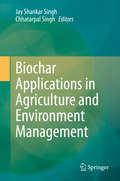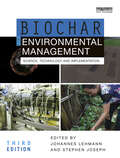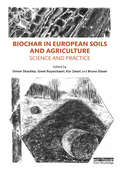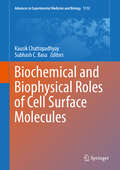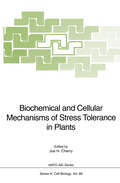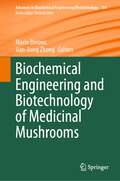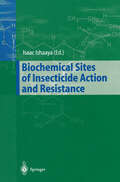- Table View
- List View
Biochar Applications in Agriculture and Environment Management
by Jay Shankar Singh Chhatarpal SinghThis book provides up-to-date information on biochar use in management of soil health, agriculture productivity, green-house gases, restoration ecology and environment. Biochar application to nutrient deficient and disturbed soils is a viable option which may promotes advances in food safety and food security to human nutrition and overall fundamental research in the agricultural sciences. The book describes in detail how the recalcitrant biochar is able to persist for long periods of time and work as a shelter for soil microbial colonisation and their biomass/numbers. This book also includes contents related to important role of biochar applications in the restoration of contaminated agricultural soils. The book will be of particular interest to students, teachers and researchers in the disciplines.
Biochar-Based Nanocomposites for Contaminant Management: Synthesis, Contaminants Removal, and Environmental Sustainability (Advances in Science, Technology & Innovation)
by Disha Mishra Rishikesh Singh Puja KhareThis book helps the readers get a holistic understanding of the emergence of biochar-nanocomposite research. The low and long-term exposure of persistent hazardous pollutants in environment is well known for damaging the water, soil, sediments, and living biota. Thus, it is a crucial step to eliminate these pollutants from environment regimes to prevent the on-site destruction or the transfer into the food chain. Biochar is a carbon-rich solid material generated through pyrolysis of biomass, and currently, it is covering the hotspot in environmental management of pollutants. It is being utilized for the efficient immobilization and sorption of organic pollutants, heavy metals, dyes, improvement of soil redox conditions, aggregate stabilization, photocatalytic degradation, and for carbon sequestration. The fascinating properties like surface area, porous structures, functional groups, and mineral components turn it into suitable candidate for the removal of various class of pollutants from environmental matrices. Different reactions like sorption, reduction, precipitation, solidification, and degradation are mainly responsible for the effective cleaning of xenobiotics from environment through biochar application. However, rapidly evolving contaminants in the environment have made the remediation more complex, expensive, and challenging. In view of these aspects, the modification of biochar through the doping of nanometals/metal oxides/surfactants/ or chemical entities will result in modified biochar with high surface area, more functional entities, improved physical, chemical, thermal, and mechanical characteristics with more adsorptive sites. Inclusion of these exclusive properties can be done through magnetic modification, impregnation of nanometals/ metal oxides/surfactants, amination, acid/base reactions, steam activation, etc. The resulted biochar-based nanocomposites have demonstrated a vital role in remediation of persistent organic pollutants, radionuclei, and heavy metals through the various interaction mechanisms like surface complexation, π–π interaction, electrostatic interaction, hydrogen bonding, Fenton process, and photocatalytic degradation. Currently, advanced research work has been carried out for the designing of modified composites of biochar to achieve maximum removal efficiency, reusability, biotoxicity, and sustainability. Hence, for selective removal of pollutants through designed biochar surface with the focused experimentation toward optimization of feedstocks, process variables, appropriate impregnation of nanomaterials, interaction with secondary pollutants, physical environment, longevity, and regeneration will definitely pave the way for safe and commercial application of biochar-based nanocomposites.
Biochar for Environmental Management: Science, Technology and Implementation
by Stephen Joseph Johannes LehmannFully revised and updated for its third edition, this book presents the definitive compilation of current knowledge on all aspects of biochar.Research on biochar continues to accelerate as its importance for soil health, climate change mitigation and adoption, and the circular economy becomes more widely acknowledged. This book not only reviews recent advances made in our understanding of biochar properties, behavior, and effects in agriculture, environmental management, and material production, but specifically develops fundamental principles and frameworks of biochar science and application. This third edition has been fully revised and updated to reflect recent developments and growing trends, with important coverage of the application of biochar outside of its traditional soil-based uses, the commercialization of biochar, and its incorporation into policy. This includes brand new chapters on the role of biochar-based materials for environmental remediation, building construction, and animal feed, and a greater discussion of biochar's role in the circular economy, climate change mitigation, and sustainable development. Overall, this book provides a systematic, comprehensive, and global examination of biochar. Written by an international team of academics and professionals, it addresses its uses, production, and management and its broader potential for mitigating climate change and driving forward sustainable development.Edited by two leading figures in the field, Biochar for Environmental Management is essential reading for students, scholars, practitioners, and policymakers interested in biochar and the role it can play in environmental sustainability and global sustainable development.
Biochar for Environmental Management: Science, Technology and Implementation
Fully revised and updated for its third edition, this book presents the definitive compilation of current knowledge on all aspects of biochar.Research on biochar continues to accelerate as its importance for soil health, climate change mitigation and adoption, and the circular economy becomes more widely acknowledged. This book not only reviews recent advances made in our understanding of biochar properties, behavior, and effects in agriculture, environmental management, and material production, but specifically develops fundamental principles and frameworks of biochar science and application. This third edition has been fully revised and updated to reflect recent developments and growing trends, with important coverage of the application of biochar outside of its traditional soil-based uses, the commercialization of biochar, and its incorporation into policy. This includes brand new chapters on the role of biochar-based materials for environmental remediation, building construction, and animal feed, and a greater discussion of biochar's role in the circular economy, climate change mitigation, and sustainable development. Overall, this book provides a systematic, comprehensive, and global examination of biochar. Written by an international team of academics and professionals, it addresses its uses, production, and management and its broader potential for mitigating climate change and driving forward sustainable development.Edited by two leading figures in the field, Biochar for Environmental Management is essential reading for students, scholars, practitioners, and policymakers interested in biochar and the role it can play in environmental sustainability and global sustainable development.
Biochar in European Soils and Agriculture: Science and Practice
by Simon Shackley Greet Ruysschaert Kor Zwart Bruno GlaserThis user-friendly book introduces biochar to potential users in the professional sphere. It de-mystifies the scientific, engineering and managerial issues surrounding biochar for the benefit of audiences including policy makers, landowners and farmers, land use, agricultural and environmental managers and consultants, industry and lobby groups and NGOs. The book reviews state-of-the-art knowledge in an approachable way for the non-scientist, covering all aspects of biochar production, soil science, agriculture, environmental impacts, economics, law and regulation and climate change policy. Chapters provide ‘hands-on’ practical information, including how to evaluate biochar and understand what it is doing when added to the soil, how to combine biochar with other soil amendments (such as manure and composts) to achieve desired outcomes, and how to ensure safe and effective use. The authors also present research findings from the first coordinated European biochar field trial and summarize European field trial data. Explanatory boxes, infographics and concise summaries of key concepts are included throughout to make the subject more understandable and approachable.
Biochar in European Soils and Agriculture: Science and Practice
by Simon Shackley Greet Ruysschaert Kor Zwart Bruno GlaserThis user-friendly book introduces biochar to potential users in the professional sphere. It de-mystifies the scientific, engineering and managerial issues surrounding biochar for the benefit of audiences including policy makers, landowners and farmers, land use, agricultural and environmental managers and consultants, industry and lobby groups and NGOs. The book reviews state-of-the-art knowledge in an approachable way for the non-scientist, covering all aspects of biochar production, soil science, agriculture, environmental impacts, economics, law and regulation and climate change policy. Chapters provide ‘hands-on’ practical information, including how to evaluate biochar and understand what it is doing when added to the soil, how to combine biochar with other soil amendments (such as manure and composts) to achieve desired outcomes, and how to ensure safe and effective use. The authors also present research findings from the first coordinated European biochar field trial and summarize European field trial data. Explanatory boxes, infographics and concise summaries of key concepts are included throughout to make the subject more understandable and approachable.
Biochemical and Biological Markers of Neoplastic Transformation: (pdf) (Nato Science Series A: #57)
by Prakash ChandraBiochemical and Biophysical Roles of Cell Surface Molecules (Advances in Experimental Medicine and Biology #1112)
by Kausik Chattopadhyay Subhash C. BasuCell surface small molecules and macromolecules, such as members of cholesterol family (including steroid hormones), the glycolipid family (sphingolipids), the glycoprotein family (both N-linked and O-linked), and a vast array of other receptors have been shown to be involved in normal and abnormal cellular processes. The 11th International Symposium on Cell Surface Macromolecules, held in Mohali, India, in February 2017 provided a comprehensive update on the major advances in this area. Presenting selected contributions from this meeting, this book comprises 24 chapters, which provide in-depth analyses of data on the role of cell surface macromolecules in cellular function and their alterations associated with pathological conditions. It includes comprehensive research papers and critical overviews of the functional role of cell surface molecules, discussing topics such as biochemical, biophysical, and cell biological approaches to study cell membrane molecules, and metabolism of glycoconjugates.
Biochemical and Cellular Mechanisms of Stress Tolerance in Plants (Nato ASI Subseries H: #86)
by Joe H. CherryEnvironmental stresses, such as high and low temperature, salinity, and drought, represent limiting factors to agricultural productivity worldwide. Their impact is not only on crops that are presently being cultivated, but they are also significant barriers to the introduction of crop plants into noncultivated areas. The book describes the cellular, biochemical, and molecular mechanisms in plants that regulate tolerance to stresses. Also discussed are prospects of engineering stress-tolerant plants through the modification of germplasm.
Biochemical and Environmental Bioprocessing: Challenges and Developments
by M. Jerold V. SivasubramanianThe rapid growth of industries has resulted in the generation of high volume of solid and liquid waste. Today, there is a need of Clean and Green technology for the sustainable waste management. Biochemical and Environmental Bioprocessing: Challenges and Developments explore the State-of-art green technologies to manage the waste and to recover value added products. Microbes play an important role in the bioremediation. Bioprocess engineering an interdisciplinary connects the Science and Technology. The bioconversion and bioremediation is essentially required for the management of various hazardous substances in the environment. This book will give an intensive knowledge on the application of Biochemical and Bioprocess technologies for the eco-friendly management of pollution. This book serves as a fundamental to the students, researchers, academicians and Engineers working in the area of Environmental Bioremediation and in the exploration of various bioproducts from waste. Features Reviews various biological methods for the treatment of effluents from Industries by using biomass and biopolymers. Highlights the applications of various bioreactors like Anaerobic Sequential Batch Reactor, Continuously stirred anaerobic digester, Up-flow anaerobic sludge blanket reactor, Fluidized and expanded bed reactors. Presents the cultivation of algae in Open Pond, Closed loop System, and Photo-bioreactors for bioenergy production. Discusses the intensified and integrated biorefinery approach by Microwave Irradiation, Pyrolysis, Acoustic cavitation, Hydrodynamic cavitation, Electron beam irradiation, High pressure Autoclave reactor, Steam explosion and photochemical oxidation. Outlines the usage of microbial fuel cell (MFC) for the production bioelectricity generation in different modules Tubular MFC, Stacked MFC, Separate electrode modules Cutting edge research of synthesis of biogenic nanoparticles and Pigments by green route for the health care and environment management.
Biochemical and Environmental Bioprocessing: Challenges and Developments
by M. Jerold V. SivasubramanianThe rapid growth of industries has resulted in the generation of high volume of solid and liquid waste. Today, there is a need of Clean and Green technology for the sustainable waste management. Biochemical and Environmental Bioprocessing: Challenges and Developments explore the State-of-art green technologies to manage the waste and to recover value added products. Microbes play an important role in the bioremediation. Bioprocess engineering an interdisciplinary connects the Science and Technology. The bioconversion and bioremediation is essentially required for the management of various hazardous substances in the environment. This book will give an intensive knowledge on the application of Biochemical and Bioprocess technologies for the eco-friendly management of pollution. This book serves as a fundamental to the students, researchers, academicians and Engineers working in the area of Environmental Bioremediation and in the exploration of various bioproducts from waste. Features Reviews various biological methods for the treatment of effluents from Industries by using biomass and biopolymers. Highlights the applications of various bioreactors like Anaerobic Sequential Batch Reactor, Continuously stirred anaerobic digester, Up-flow anaerobic sludge blanket reactor, Fluidized and expanded bed reactors. Presents the cultivation of algae in Open Pond, Closed loop System, and Photo-bioreactors for bioenergy production. Discusses the intensified and integrated biorefinery approach by Microwave Irradiation, Pyrolysis, Acoustic cavitation, Hydrodynamic cavitation, Electron beam irradiation, High pressure Autoclave reactor, Steam explosion and photochemical oxidation. Outlines the usage of microbial fuel cell (MFC) for the production bioelectricity generation in different modules Tubular MFC, Stacked MFC, Separate electrode modules Cutting edge research of synthesis of biogenic nanoparticles and Pigments by green route for the health care and environment management.
Biochemical Engineering: A Textbook for Engineers, Chemists and Biologists
by Shigeo Katoh Jun-ichi Horiuchi Fumitake YoshidaCompletely revised, updated, and enlarged, this second edition now contains a subchapter on biorecognition assays, plus a chapter on bioprocess control added by the new co-author Jun-ichi Horiuchi, who is one of the leading experts in the field. The central theme of the textbook remains the application of chemical engineering principles to biological processes in general, demonstrating how a chemical engineer would address and solve problems. To create a logical and clear structure, the book is divided into three parts. The first deals with the basic concepts and principles of chemical engineering and can be read by those students with no prior knowledge of chemical engineering. The second part focuses on process aspects, such as heat and mass transfer, bioreactors, and separation methods. Finally, the third section describes practical aspects, including medical device production, downstream operations, and fermenter engineering. More than 40 exemplary solved exercises facilitate understanding of the complex engineering background, while self-study is supported by the inclusion of over 80 exercises at the end of each chapter, which are supplemented by the corresponding solutions. An excellent, comprehensive introduction to the principles of biochemical engineering.
Biochemical Engineering: A Textbook for Engineers, Chemists and Biologists
by Shigeo Katoh Jun-ichi Horiuchi Fumitake YoshidaCompletely revised, updated, and enlarged, this second edition now contains a subchapter on biorecognition assays, plus a chapter on bioprocess control added by the new co-author Jun-ichi Horiuchi, who is one of the leading experts in the field. The central theme of the textbook remains the application of chemical engineering principles to biological processes in general, demonstrating how a chemical engineer would address and solve problems. To create a logical and clear structure, the book is divided into three parts. The first deals with the basic concepts and principles of chemical engineering and can be read by those students with no prior knowledge of chemical engineering. The second part focuses on process aspects, such as heat and mass transfer, bioreactors, and separation methods. Finally, the third section describes practical aspects, including medical device production, downstream operations, and fermenter engineering. More than 40 exemplary solved exercises facilitate understanding of the complex engineering background, while self-study is supported by the inclusion of over 80 exercises at the end of each chapter, which are supplemented by the corresponding solutions. An excellent, comprehensive introduction to the principles of biochemical engineering.
Biochemical Engineering: A Textbook for Engineers, Chemists and Biologists
by Shigeo Katoh Fumitake YoshidaWritten by renowned professors drawing on their experience gained in the world's most innovative biotechnology market, Japan, this advanced textbook provides an excellent and comprehensive introduction to the latest developments in the field. It provides an array of questions & answers and features numerous applied examples, extending to industrial applications with chapters on medical devices and downstream operations in bioprocesses. Useful for students studying the fundamentals of biochemical engineering, as well as for chemical engineers already working in this vital and expanding field.
Biochemical Engineering and Biotechnology of Medicinal Mushrooms (Advances in Biochemical Engineering/Biotechnology #184)
by Marin Berovic Jian-Jiang ZhongThis book offers a comprehensive review of the latest developments in medicinal mushroom biochemical engineering and biotechnology, and it also analyses the circular economy of mushroom bioproduction. Divided into 13 chapters, the book begins with a historical perspective of medicinal mushrooms, followed by authoritative chapters that explore the farming of medicinal mushrooms and bioeconomy, as well as the limitations of using medicinal mushrooms to produce metabolites. Subsequent chapters cover topics such as solid-state and submerged cultivation of medicinal mushroom mycelia in bioreactors, pilot and industrial bioreactor cultivation experiences, downstream processing of medicinal mushroom products, and biochemistry of medicinal mushroom bioactive compounds. Particular attention is given to the recent genetic engineering techniques applied in mushroom cultivation. The book closes with a chapter devoted to the health and clinical benefits of medicinal fungi, where readers will find expert insights into the therapeutic implications of medicinal fungi. In this book, readers will find an authoritative perspective on the past, present and future of medicinal mushrooms, and will also learn about some recent clinical studies with isolates from these natural products. Given its breadth, this book will appeal to biotechnologists working in mushroom cultivation, as well as to professionals interested in traditional pharmacy and medicine.
Biochemical Engineering for 2001: Proceedings of Asia-Pacific Biochemical Engineering Conference 1992
by Shintaro Furusaki Isao Endo Ryuichi MatsunoBiochemical engineering forms a bridge between fundamental biochemical research and large scale biotechnology processes. It covers genetic and protein engineering, cell culture, bioprocess and reactor design, separation and modelling. Research work in biochemical engineering is an investment in the future, when conventional resources will have to be replaced with renewable ones. In this book the papers presented at the Asia-Pacific Biochemical Engineering Conference (Yokohama, Japan 1992) are collected. This collection is unique in its wide coverage of topics and it gives an overview of the current trends of research in an important area.
Biochemical Mechanisms of Detoxification in Higher Plants: Basis of Phytoremediation
by George Kvesitadze Gia Khatisashvili Tinatin Sadunishvili Jeremy J. RamsdenPlants play a key role in purifying the biosphere of the toxic effects of industrial activity. This book shows how systematic application of the results of investigations into the metabolism of xenobiotics (foreign, often toxic substances) in plants could make a vastly increased contribution to planetary well-being. Deep physiological knowledge gained from an accumulation of experimental data enables the great differences between the detoxifying abilities of different plants for compounds of different chemical nature to be optimally exploited. Hence planting could be far more systematically adapted to actual environmental needs than is actually the case at present. The book could form the basis of specialist courses in universities and polytechnics devoted to environmental management, and advanced courses in plant physiology and biochemistry, for botany and integrative biology students. Fundamental plant physiology and biochemistry from the molecular level to whole plants and ecosystems are interwoven in a powerful and natural way, making this a unique contribution to the field.
Biochemical Sites of Insecticide Action and Resistance
by Isaac IshaayaIn recent years many of the conventional methods of insect control by broad spectrum synthetic chemicals have come under scrutiny because of their unde sirable effects on human health and the environment. In addition, some classes of pesticide chemistry, which generated resistance problems and severely affected the environment, are no longer used. It is against this background that the authors of this book present up-to-date findings-relating to biochemical sites that can serve as targets for developing insecticides with selective prop erties, and as the basis for the elucidation of resistance mechanisms and countermeasures. The book consists of eight chapters relating to biochemical targets for insec ticide action and seven chapters relating to biochemical modes of resistance and countermeasures. The authors of the chapters are world leaders in pesti cide chemistry, biochemical modes of action and mechanisms of resistance. Biochemical sites such as chitin formation, juvenile hormone and ecdysone receptors, acetylcholine and GABA receptors, ion channels, and neuropeptides are potential targets for insecticide action. The progress made in recent years in molecular biology (presented in depth in this volume) has led to the iden tification of genes that confer mechanisms of resistance, such as increased detoxification, decreased penetration and insensitive target sites. A combina tion of factors can lead to potentiation of the resistance level. Classifications of these mechanisms are termed gene amplification, changes in structural genes, and modification of gene expression.
Biochemie der Ernährung
by Gertrud Rehner Hannelore DanielDas erfolgreiche und gut eingeführte Werk Biochemie der Ernährung von Gertrud Rehner und Hannelore Daniel liegt nunmehr in der dritten Auflage vor und eignet sich als Lehrbuch für Studenten der Ernährungswissenschaft wie auch als Nachschlagewerk für Ernährungswissenschaftler, Mediziner, Biologen und Chemiker. Bei diesem didaktisch herausragenden Lehrbuch stehen die Zell- und Organfunktionen im Vordergrund. Den Autorinnen gelingt es damit, einen verständlichen Zusammenhang zwischen den biochemischen Fakten und den Prozessen der Ernährungsphysiologie herzustellen. Ergänzt werden die Texte durch anschauliche zweifarbige Abbildungen. Stimmen zu den vorigen Auflagen >>Das mit dem didaktischen Geschick hervorragend aufgebaute und griffig gegliederte, den anspruchsvollen, bis in die molekularen Dimensionen führenden Stoff mit zahlreichen Abbildungen, Tabellen, und Formeln sehr anschaulich vermittelnde Werk verrät Lehrerfahrung und Einfühlungsvermögen. ... Für Studierende der Ernährungswissenschaft sollte das als Lehrbuch beworbene Werk zur Prüfungslektüre erhoben werden.>Das lehrerprobte Team im Studiengang Ernährungswissenschaft in Gießen hat die Lücke gefüllt und für Studierende der Ernährungswissenschaften, ernährungsmedizinisch interessierte Medizinstudenten und Diätassistenzberufe aus der riesigen Fülle des Stoffes der Biochemie und Molekularbiologie jene Stoffe ausgewählt, die für ernährungsbiochemische Komplexe wichtig sind.>Dies ist ein in mehrfacher Hinsicht ungewöhnliches Buch. Zu den wichtigsten Besonderheiten gehört die grundsätzliche didaktische Vorgehensweise. ... Seine besondere Konzeption, die vermittelten Inhalte sowie viele Abbildungen, sehr durchdacht konzipiert, instruktiv und mit eindrucksvoller Einfachheit entworfen, dürften ihm eine zahlreiche Leserschaft sowohl unter Studenten als auch Fachkollegen der Ernährungswissenschaft, Medizin, Biochemie und Biologie sichern.>Treffende und breit angelegte Information über die biochemischen Abläufe der menschlichen Ernährung / Stoffwechsels.^
Biochemie für Mediziner: Ein Lern- und Arbeitsbuch mit klinischem Bezug
by Markus Linnemann Michael KühlIn der medizinischen Grundlagenforschung nimmt die Biochemie einen immer bedeutenderen Rang ein, doch leider stellt das Fach nur all zu oft eine der großen Hürden vor dem Physikum dar. Mit diesem Lehrbuch versuchen nun die Autoren Linnemann und Kühl, dem geschilderten Mißstand Abhilfe zu verschaffen. Dieses Lehrbuch der Biochemie wendet sich an Studenten der Medizin und der Zahnmedizin im vorklinischen Studienabschnitt. Eine verständliche und präzise Darstellung im Verein mit vielen erläuternden Abbildungen und zusammenfassenden Tabellen ermöglichen ein effizientes Erlernen aller relevanten Prüfungsthemen. Auf diese Weise trägt das Buch dem Zeitmangel von Studentinnen und Studenten Rechnung, wo nötig, wird Erklärungen angemessen und ausreichend Platz eingeräumt. Gemäß den heutigen Prüfungsanforderungen wird die Biochemie fächerübergreifend dargestellt, wobei auf ausführliche klinische Bezüge (Pathobiochemie, klinische Chemie) besonderer Wert gelegt wurde. Das Buch wurde bereits in drei Auflagen erfolgreich im Selbstverlag vertrieben.
Biochemische Grundlagen der Lebensmittelfrischhaltung (Handbuch der Kältetechnik #9)
by Milan Bier Willibald DiemairBiochemistry and Molecular Biology of Wood (Springer Series in Wood Science)
by Takayoshi HiguchiProgress in wood chemistry has been related mainly to chemical wood pulping and bleaching and chemical utilization of wood and wood extractives. Meth ods of wood analysis were developed by Schorger (proximate analysis in 1917) and Dore (summative analysis in 1919), and standard methods based on Schorger's method, e.g., TAPPI standards (Technical Association of the Pulp and Paper Industry), have been widely used for chemical analysis of woods in many countries. Thus it is generally known that wood is composed of about 50% cellulose, 20-35% of lignin, 15-25% of hemicelluloses, and variable amounts of extractives. Chemical characterization and efficient utilization of these wood components have been studied in laboratories of wood chemistry and technology in universities and government institutions. In the last decade, biochemistry and molecular biology of microorganisms, animals, and plants have greatly progressed. At the same time wood has been recognized as a unique renewable ecomaterial produced by trees using solar energy. In addition, many desirable properties of wood and wood components as biomaterial that affects physiology and psychology in humans have recently attracted attention.
Biochemistry and Physiology of Herbicide Action
by Carl FedtkeHerbicides are part of modern agricultural production systems and therefore contribute significantly to the economy of agricultural products. At the same time, herbicides are potent and specific inhibitors of plant metabolism and may therefore be used as valuable tools in basic plant physiological research. A well-known example is the photosynthesis-inhibiting herbicide diuron, known to plant physiologists as DCMU, which has become one of the essentials in modern photosynthesis research. Similarly, knowledge in other areas of plant metabolism may be advanced by the use of herbicides as specific inhibitors. This book describes the effects of herbicides on the metabolism of higher plants from the viewpoint of the plant physiologist. The material of this book is therefore, as far as possible, divided into areas of metabolism. This book intends (1) to present the reader with current knowledge and views in the area of herbicide modes of action and (2) to promote the future use of herbicides as metabolic inhibitors in plant physiological research to the advantage of both, the pesticide and the plant sciences. I wish to express my thanks to my colleagues and friends Prof. N. Amrhein, Prof. E. Elstner, Dr. L. Eue, Dr. J. Konze, Dr. K. Liirssen, Dr. W.Oettmeier, Dr. H. Quader, Dr. R. R. Schmidt, Dr. R. H. Shimabukuro, Dr. J. Stetter, Prof.
Biochemistry and Physiology of Plant Hormones
by Thomas C. MooreBiochemistry and Physiology oj Plant Hormones is intended primarily as a textbook or major reference for a one-term intermediate-level or advanced course dealing with hormonal regulation of growth and development of seed plants for students majoring in biology, botany, and applied botany fields such as agronomy, forestry, and horticulture. Additionally, it should be useful to others who wish to become familiar with the topic in relation to their principal student or professional interests in related fields. It is assumed that readers will have a background in fundamental biology, plant physiology, and biochemistry. The dominant objective of Biochemistry and Physiology oj Plant Hor mones is to summarize, in a reasonably balanced and comprehensive way, the current state of our fundamental knowledge regarding the major kinds of hormones and the phytochrome pigment system. Written primarily for students rather than researchers, the book is purposely brief. Biochemical aspects have been given priority intentionally, somewhat at the expense of physiological considerations. There are extensive citations of the literature-both old and recent-but, it is hoped, not so much documentation as to make the book difficult to read. The specific choices of publications to cite and illustrations to present were made for different reasons, often to illustrate historical develop ment, sometimes to illustrate ideas that later proved invalid, occasionally to exemplify conflicting hypotheses, and most often to illustrate the current state of our knowledge about hormonal phenomena.
